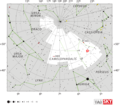astro.wikisort.org - Galaxy
NGC 1502 is a young[6] open cluster of approximately 60[3] stars in the constellation Camelopardalis, discovered by William Herschel on November 3, 1787.[7] It has a visual magnitude of 6.0 and thus is dimly visible to the naked eye.[3] This cluster is located at a distance of approximately 3,500 light years[1][2] from the Sun, at the outer edge of the Cam OB1 association of co-moving stars, and is likely part of the Orion Arm.[2] The asterism known as Kemble's Cascade appears to "flow" into NGC 1502, but this is just a chance alignment of stars.[8]
 NGC 1502 (taken from Stellarium) | |
| Observation data (J2000 epoch) | |
|---|---|
| Constellation | Camelopardalis |
| Right ascension | 04h 07m 48.96s[1] |
| Declination | +62° 19′ 55.2″[1] |
| Distance | 3,452 ly (1,058.4 pc)[1] 3,643+313 −290 ly (1,117+96 −89 pc)[2] |
| Apparent magnitude (V) | 6.0[3] |
| Apparent dimensions (V) | 9.7′[1] |
| Physical characteristics | |
| Radius | 5.5 ly (1.7 pc)[4] |
| Estimated age | 5 Myr[2] |
| Other designations | NGC 1502,[5] Cr 45 |
The Trumpler class of NGC 1502 is II3p, indicating poorly populated cluster of stars (p) with a wide brightness range (3). The main sequence turnoff point is not well-defined, so the age estimates range from five to fifteen million years.[6] It is heavily reddened due to interstellar dust.[4] One of the brightest candidate members of the cluster is the eclipsing binary SZ Cam, which is a component of a visual double star ADS 2984.[2] There are eleven variable stars and four candidate variables among the cluster members, including a β Cep, two periodic B-type variables, 2–3 eclipsing variables, and an RR Lyrae star.[6] Five members of the cluster are chemically peculiar.[9]
Gallery
 The location of NGC 1502 (circled in red)
The location of NGC 1502 (circled in red)
See also
- Alpha Camelopardalis, a runaway star possibly ejected from this cluster.[6]
References
- Cantat-Gaudin, T.; Anders, F. (January 2020). "Clusters and mirages: cataloguing stellar aggregates in the Milky Way". Astronomy & Astrophysics. 633: 22. arXiv:1911.07075. Bibcode:2020A&A...633A..99C. doi:10.1051/0004-6361/201936691. A99.
- Topasna, G. A.; et al. (August 2018). "Interstellar polarization and extinction towards the young open cluster NGC 1502". Astronomy & Astrophysics. 615: 16. Bibcode:2018A&A...615A.166T. doi:10.1051/0004-6361/201731903. A166.
- O'Meara, Steve (2007). Herschel 400 Observing Guide. Cambridge University Press. p. 35. ISBN 9780521858939.
- Tripathi, A.; et al. (September 2013). "Photometric study of Galactic open cluster NGC 2129, NGC 1502 and King 12". Bulletin of the Astronomical Society of India. 41 (3): 209. Bibcode:2013BASI...41..209T.
- "NGC 1502". SIMBAD. Centre de données astronomiques de Strasbourg. Retrieved 2022-01-10.
- Michalska, G.; et al. (December 2009). "A CCD Search for Variable Stars of Spectral Type B in the Northern Hemisphere Open Clusters. VII. NGC 1502". Acta Astronomica. 59 (4): 349–370. arXiv:0910.3672. Bibcode:2009AcA....59..349M.
- Seligman, Courtney. "Celestial Atlas: NGC Objects: NGC 1500 - 1549". cseligman.com. Retrieved 2022-01-10.
- Thompson, Robert; Thompson, Barbara (2007). Illustrated Guide to Astronomical Wonders, From Novice to Master Observer. O'Reilly Media. p. 111. ISBN 9780596526856.
- Paunzen, E.; et al. (November 2005). "CCD photometric search for peculiar stars in open clusters. VI. NGC 1502, NGC 3105, Stock 16, NGC 6268, NGC 7235 and NGC 7510". Astronomy and Astrophysics. 443 (1): 157–162. arXiv:astro-ph/0508151. Bibcode:2005A&A...443..157P. doi:10.1051/0004-6361:20053287.
External links
 Media related to NGC 1502 at Wikimedia Commons
Media related to NGC 1502 at Wikimedia Commons- NGC 1502 on WikiSky: DSS2, SDSS, GALEX, IRAS, Hydrogen α, X-Ray, Astrophoto, Sky Map, Articles and images
На других языках
[de] NGC 1502
NGC 1502 ist die Bezeichnung für einen Offenen Sternhaufen im Sternbild Giraffe. NGC 1502 hat eine Winkelausdehnung von 20,0' und eine scheinbare Helligkeit von 6,9 mag. Vier mit Helligkeiten von 7 bis 8 mag deutlich auffälligere O- und B-Sterne dominieren etwa 45 weitere Haufenmitglieder mit Helligkeiten von 9 bis 11 mag. NGC 1502 befindet sich am Ende des auffälligen Asterismus Kembles Kaskade.[5]- [en] NGC 1502
[ru] NGC 1502
NGC 1502 (другое обозначение — OCL 383) — рассеянное звёздное скопление в созвездии Жираф.Другой контент может иметь иную лицензию. Перед использованием материалов сайта WikiSort.org внимательно изучите правила лицензирования конкретных элементов наполнения сайта.
WikiSort.org - проект по пересортировке и дополнению контента Википедии
